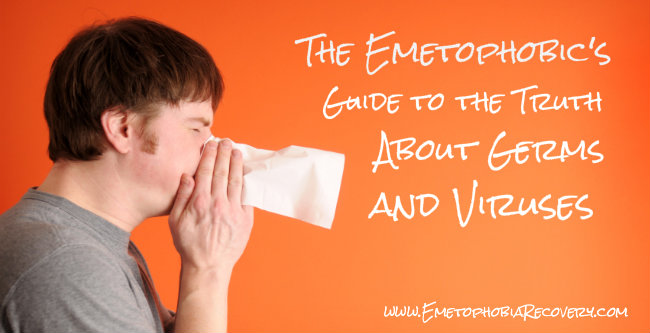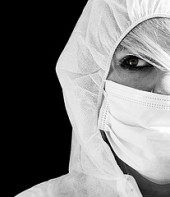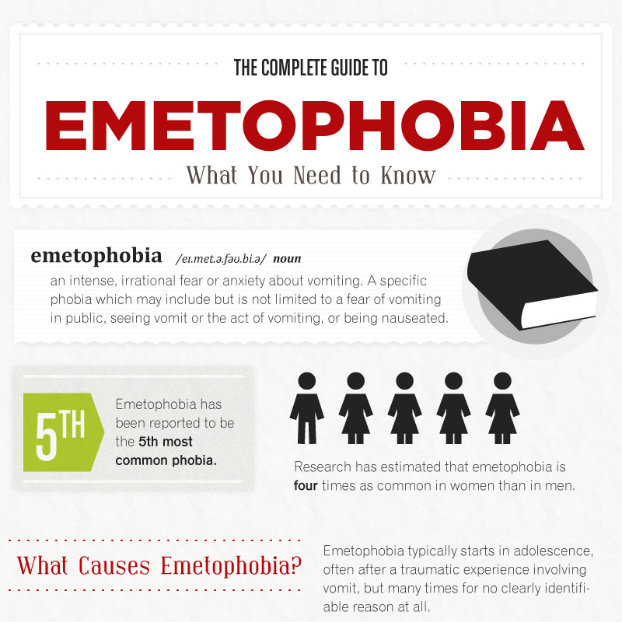 Germs get a very bad rap, especially from emetophobics, but the truth is the term itself is neither scary nor harmful. The word germ in its most basic definition simply means a microscopic organism. Granted, the term is most heavily used when that microscopic organism is one that spreads disease, but the word itself can have positive or even neutral connotations.
Germs get a very bad rap, especially from emetophobics, but the truth is the term itself is neither scary nor harmful. The word germ in its most basic definition simply means a microscopic organism. Granted, the term is most heavily used when that microscopic organism is one that spreads disease, but the word itself can have positive or even neutral connotations.
Think of wheat germ, which isn’t typically harmful unless you’re allergic to wheat. You can also recall the verb germinate, which simply means to sprout or grow.
Okay, we’ll give you that. Germs themselves can germinate into a very unhealthy, infected environment, but you’ll do better at protecting yourself in that environment if you know exactly what you’re up against. Keep in mind that what we’ll be talking about in this post isn’t meant to scare you or to imply that you should make decisions around your fear, but to simply help you make more informed choices based on the truth rather than your phobia. Even after you’ve started a program like ours to conquer the fear that’s holding you back, it’s still a good idea to avoid getting sick when you can!
How Germs are Spread
While many germs enter your body through your respiratory system or the air you breathe, others prefer different avenues. Waterborne germs can enter your body through the water you drink. Others, such as those causing HIV, can enter through bodily fluids and still others, like good ole E. coli, can come from the food you eat.
The germs that have the potential to do you harm are sometimes referred to as infectious agents, with some of the most common noted below.
Different Types of Infectious Agents
 Bacteria: Bacteria are tiny, one-celled organisms that look like little spheres, rods or spirals. They can live and thrive on their own without any host to support them. Yogurt-eating folks already know not all bacteria are harmful. In fact, bacteria found in yogurt can actually beneficial. Your intestines are lined with bacteria that help your body digest your foods and defend itself against disease while supplying much-needed nutrients. And then there’s the minority.
Bacteria: Bacteria are tiny, one-celled organisms that look like little spheres, rods or spirals. They can live and thrive on their own without any host to support them. Yogurt-eating folks already know not all bacteria are harmful. In fact, bacteria found in yogurt can actually beneficial. Your intestines are lined with bacteria that help your body digest your foods and defend itself against disease while supplying much-needed nutrients. And then there’s the minority.
Less than 1 percent of bacteria cause disease, but when they intend to do harm, watch out. Urinary tract infections, strep throat and tuberculosis are all caused by bacteria, with bacteria often getting its kicks by creating toxins that wreak havoc on our cells and make us sick.
Other infectious agents: Other infectious agents are larger than bacteria and are typically not as commonly name-dropped by those suffering from emetophobia. But they can be just as nasty as their bacterial cousins when it comes to making you sick. They include fungi, protozoa and helminths.
Fungi: Mushrooms, anyone? As mushrooms indicate, some may find certain types of fungi quite delicious while other types are responsible for things like yeast infections, ringworm and athlete’s foot.
Protozoa: These single-celled organisms go hunting and gathering to eat other microbes. They also come in harmless varieties, such as those that hang out with the beneficial bacteria in your intestine. The non-harmless varieties are behind malaria, giardia, toxoplasmosis and include several other water-borne organisms that can leave you with diarrhea, nausea and vomiting.
Helminths: Tapeworms, roundworms and other fairly large and particularly needy parasites are part of the helminth category of infectious agents. Helminth is the Greek word for worm, and these worms can enter your body and make themselves quite at home wherever they or their eggs may land. Helminths can thrive in your lungs, liver, intestines, skin or even your brain, living off the same nutrients that fuel the rest of your body and causing loads of damage in the process.
What Are Viruses and Where Do They Fit in?
 As a microscopic organism, viruses fall into the germ category, although they have some major differences than other types of infectious agents. Emetophobiacs may be relieved to know the major difference between viruses and other infectious agents is their inability to live for sustained periods on their own without a host cell. They also differ from bacteria and other germs by not being affected by antibiotics.
As a microscopic organism, viruses fall into the germ category, although they have some major differences than other types of infectious agents. Emetophobiacs may be relieved to know the major difference between viruses and other infectious agents is their inability to live for sustained periods on their own without a host cell. They also differ from bacteria and other germs by not being affected by antibiotics.
And if you thought bacteria were tiny, wait until you get a load of a virus. In fact, you would need a load of viruses just to equal the size of a single bacterium. Viruses are shaped like spheres, rods or teeny tadpoles and typically end up killing off the cell the cells they infect, since they invade cells and pretty much take over. Viruses are responsible for a laundry list of maladies that include flu and the common cold, AIDS, measles, smallpox and genital herpes.
Germ Havens Explained
As ubiquitous as germs may seem to someone struggling with emetophobia, not every single thing you touch, taste or see is going to be dancing with germs. Certain environments are not friendly to germs at all whereas others are ideal places for them to thrive.
Germs particularly enjoy environments that are:
Warm: Let’s see, somewhere around 98.6 F is the ultimate germ haven temperature for many infectious agents, according to the Massachusetts Water Resources Authority. That warm and cozy temperature is where they really get their motors running. That is also, as you probably noticed, our average body temperature.
Wet: Arid areas make germs quickly lose the very water they need to survive. Moist or damp environments keep them flush and plump. The longer viruses and their pals have moisture to sustain them, the longer they can survive outside of a host.
Dark: It’s not just ne’er-do-wells and murderers who are known to come out at night. Most germs prefer the darkness, too.
Packed with nutrients: Since germs can’t really mosey on over to the grill and hook up a steak, they have to rely on their immediate environment for nourishment. Once again, the human body reigns supreme as the perfect place to get it. That means crowded environments are a boon for germs, especially those environments that have poor air circulation, such as a packed airplane or a stuffy classroom.
Germ Myths: True or False?
 The myths about germs may be as rampant as the germs themselves, even for those who do not harbor any vomit phobias. With the University of Arizona reporting that certain germs can divide from a single germ to 8 million germs in a single day, you can bet the myths are rampant.
The myths about germs may be as rampant as the germs themselves, even for those who do not harbor any vomit phobias. With the University of Arizona reporting that certain germs can divide from a single germ to 8 million germs in a single day, you can bet the myths are rampant.
You can’t get sick from touching a doorknob.
FALSE. You certainly can be infected with germs and even viruses from touching any infected surface. Not all doorknobs are suspect, however, only those that have been recently touched by someone else who is already infected.
“Free living germs like bacteria and fungi can survive on inanimate objects longer than viruses,” reminds Kelly Reynolds, associate professor at University of Arizona’s College of Public Health. While the lifespan of some germs on objects is quite brief, others, such as the rhinovirus germ, can survive up to 24 hours.
A sneeze can send germs hurling through the air at speeds up to 80 mph.
TRUE. Covering your nose and mouth when you sneeze or cough is a gesture that goes far beyond just being polite. Coughing and sneezing can spew germs through the air attached to mucus droplets. While sneezing may send those droplets at rapid rates, the mucus droplets are too heavy to go much farther than 3 feet, UA says.
Germs that specialize in air travel, however, can go much farther. Airborne germs are rare, but they can do a whopper of an infection job by attaching themselves to dust particles or droplets of moisture in the air. Airborne travelers include the spores of anthrax bacteria and tuberculosis.
Birds are the most likely animals to infect you with some type of virus or illness.
 FALSE. While birds are high on the list of potential carriers, thanks to things like avian flu, reptiles are more likely to take first place. The Centers for Disease Control and Prevention says salmonella from pet reptiles hits about 70,000 U.S. residents per year. That means folks wanting to avoid getting sick should remember to wash their hands the next time they pet a turtle!
FALSE. While birds are high on the list of potential carriers, thanks to things like avian flu, reptiles are more likely to take first place. The Centers for Disease Control and Prevention says salmonella from pet reptiles hits about 70,000 U.S. residents per year. That means folks wanting to avoid getting sick should remember to wash their hands the next time they pet a turtle!
Also know that some illnesses are species specific, which means they can only infect a particular species. This is why your dog doesn’t catch your cold or flu. Other illnesses, however, can have a heyday with more than one species.
“In general it is the bacteria and parasites that are spread by animals,” Reynolds says. “Viruses are mostly spread through a vector or intermediate host.” Mosquitoes are a prime example of vectors as they merrily carry germs to infect people without suffering the infections themselves.
The best way to prevent infection is with anti-bacterial products.
FALSE. All those anti-bacterial soaps, body washes and cleaners can actually do more harm than good, according to a Scientific American article. While soap, bleach and other traditional means of killing off bacteria wiped everything clean, antibacterial products leave a residue on surfaces. This residue lingers and continues to kill off some bacteria, but not all bacteria.
Some bacteria can be “armed with a special defense mechanisms” that survive the onslaught. The survivors can then mutate and reproduce, creating a population of super-bacteria that don’t even blink in the face of all the anti-bacterial jazz. The same thing happens with bacteria and some antibiotics, resulting in a need for updated antibiotics. If your emetophobia set you on an anti-bacterial binge, you may want to rethink your soaps and products.
Most people wash their hands after using a public restroom.
TRUE. Thankfully this one is true. An observational study across five cities found an overall 77 percent of people washed their hands after public bathroom use. Men clocked in with washing their hands 66 percent of the time and women washed their hands 88 percent of the time. Remember, however, washing your hands does not always guarantee a germ-free experience. If an infected person failed to wash their own hands while leaving, you may once again be exposed if you touch a germy doorknob.
About half of all the food borne illness outbreaks come from slobs.
TRUE. OK, the people may not be slobs per se, but studies show that folks who practice poor personal hygiene contribute to an estimated 50 percent of food borne illness cases. Food can easily infect a wide range of people, as you have seen with recalls on spinach and other items in the past that were found to be heavy with contaminants.
You should always rinse raw chicken to get rid of bacteria.
FALSE. While giving your chicken a quick rinse before cooking may have been recommended at one time, the FDA now says rinsing raw poultry and meat can actually increase the chances of spreading germs around.
“Washing these foods makes it more likely for bacteria to spread to areas around the sink and countertops,” explains FDA consumer educator Marjorie Davidson. The safe bet is to cook the meat and poultry until it hits the FDA’s recommended safe cooking temperature. Poultry is considered safe at 165 F and beef, pork, veal and lamb at 145 F with a three-minute resting time.
All that raw egg stuff is hype; eggs are not likely to have salmonella.
 FALSE. Eggs that have undergone in-shell pasteurization are the only ones likely to be safe from the harmful Salmonella bacteria, the FDA says. All other eggs are fair game, even those with clean, unbroken. Salmonella can creep into eggs during shipping, storage or consumer handling.
FALSE. Eggs that have undergone in-shell pasteurization are the only ones likely to be safe from the harmful Salmonella bacteria, the FDA says. All other eggs are fair game, even those with clean, unbroken. Salmonella can creep into eggs during shipping, storage or consumer handling.
When making eggnog or recipes containing raw eggs, the FDA recommends going for the pasteurized in-shell variety, powdered egg whites, or pasteurized frozen or liquid egg products.
At least we can’t get infected from our gardens.
FALSE. Certain fungi kick around in the soil and then send out spores that can become airborne. If it’s a windy day or there’s lots of area construction going on, you may be especially at risk if you happen to be susceptible to whatever is blowing around. Inhaling such spores can leave you with symptoms that resemble the flu or skin and lung infections.
A pool party can be a major party for diarrhea.
TRUE. With a crowd of people and a wet environment, you already have ideal conditions for germ to thrive. Make it a heated pool and the germs can be even more heartily in business. Diarrhea is the most common illness spread in the pool, Reynolds says.
“On average, people have about 0.14 grams of feces on their bottoms,” she tells us. “When rinsed off during pool use, this can contaminate recreational water.”
Lakes, rivers and the neighborhood swimming pond can also be contaminated, thanks to germs from animal waste, human waste and sewage. While a pool has the advantage of chlorine or filtration systems that can kick out many of the germs, certain parasites can still survive.
I know just reading all of this may have given you the creeps, but stay tunes for part two when we’ll talk about how to avoid all those nasty germs, bacterias, and viruses…
This post is the first of two in our Emetophobics Guide to the Truth About Germs and Viruses. Click here to read part two.
SOURCES:
- http://www.scientificamerican.com/article.cfm?id=strange-but-true-antibacterial-products-may-do-more-harm-than-good
- http://www.fda.gov/downloads/Food/ResourcesForYou/Consumers/UCM260394.pdf
- http://www.fda.gov/Food/ResourcesForYou/Consumers/ucm077342.htm
- http://www.fda.gov/ForConsumers/ConsumerUpdates/ucm092815.htm
- http://www.mayoclinic.com/health/germs/ID00002/NSECTIONGROUP
- http://kidshealth.org/kid/talk/qa/germs.html#
- http://www.cdc.gov/ounceofprevention/docs/oop_brochure_eng.pdf
- http://www.huffingtonpost.com/2012/02/10/dirtiest-places-cleaning-tip_n_1267487.html
- http://www.nsf.org/consumer/newsroom/fact_top10_germiest_places.asp
- http://life.familyeducation.com/slideshow/germ-hot-spots/61567.html
- http://www.mwra.state.ma.us/germs/germ3.htm
- http://learnaboutgerms.arizona.edu/how_germs_spread.htm
Photo Credit: @jessewright,Ү, RєRє





